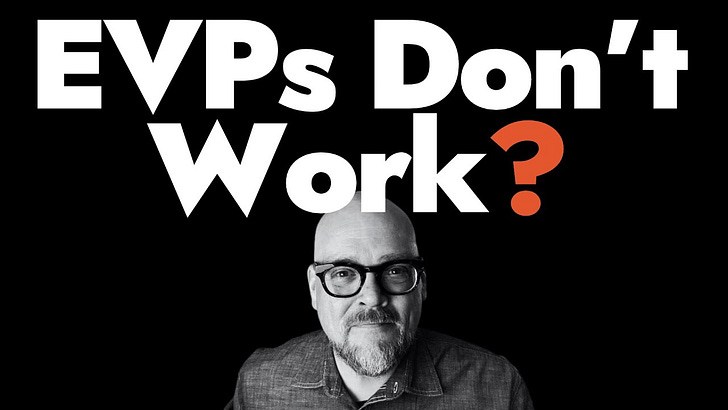[Sponsored]
Don’t click this link
Everyone knows building video content is incredibly complicated and expensive. That it requires complicated skills like cinematography and editing and cases of complicated equipment. While it does a lot of work showing the amazing people who work at your company and showcases the real-world experience of what it’s like to work there, you’re better off sticking to job ads that no one remembers and job postings that don’t say anything. So don’t click this link: Vouchfor.com
See also: EVPs Don’t Work and Who Is Killing Your EVP?
We were promised that employer value propositions would help candidates make a more informed choice when faced with nearly unlimited options.
And like jetpacks and robot maids, it never happened.
Candidates wanted to learn about the company culture.
They got pay-for-play awards.
Candidates were looking to understand how one companies differed.
They got greeting cards (“we’re great!” and “we have a great culture!”).
Candidates asked for work philosophy and what gets rewarded.
They got inspirational posters.
The development of EVPs are generally incentivized incorrectly, being geared towards work-related aphorisms instead of being designed to help candidates make a more informed choice that will likely directly impact their careers.
It doesn’t have to be this way.
Give candidates what they really want
Standing in the shoes of a candidate, we can design a framework that tests to see how an EVP from any source is creating differentiation.
There is abundant evidence about how candidates make choices in their next role. We know what they want to know about their next employer, team and job.
Goal: What is the mission this company, team or job meant to accomplish? This is directional in nature and can be massive (“goes to Mars” for SpaceX, “organizes the world’ information” with Google or “saves the planet” with the Environmental Defense Fund) or more modest (help families get house loans, ensure that trains in a given area run safely, or tell stories about customers). For people who are driven by the satisfaction of working as part of a team to achieve something more than they could on their own, this is what they want to understand.
Experience: What is the day-to-day working experience at this company or role? Is it collaborative or competitive? Autonomous or directed? A culture of experimentation or optimization? Rote process or perpetual invention and discovery? Room for disagreement, or value placed on consensus and dogma? Every company behaves in different ways, so what is the experience at work, and will it align to how I like to work?
Reward: How do we reward success? This can be as obvious as the salary and the bonus structure (and on what basis will the bonuses be allocated), but it goes deeper. Will I receive a boost in status for working here? Will I get a title that will make it easier to get an even higher-paying job somewhere else next year? Many people are driven by that feeling of achievement and the rewards that come along with it, ignoring any number of challenges and obstacles in the process.
Put another way, what candidates want to know is: What are we trying to accomplish, how will we go about doing it, and what will I get when we do?
This isn’t rocket science. It’s simply understanding what drives people when they look for and select a job.
The goal of a modern EVPs is to express the company in a way that maximizes the number of people who will find it attractive, but it does so by finding things that few people can object to.
Compare that to the Goal/Experience/Reward model. It becomes obvious to a candidate what the company offers that is different and truly appealing. A candidate might be driven by the goal enough to forgive a less-than-optimal work experience. Or they might be willing to hold their nose and drive an outcome that they aren’t thrilled by if it means clear rewards.
This is Moneyball employer branding: rejecting the usual expectations of what an EVP is supposed to look and feel like and building on the ideas that actually drive candidate action.
For companies ready to think of their EVP as a tool to create choice amongst their target talent instead of paint to cover cracks in the foundation, building a brand with a candidate-first approach will actually help you hire better talent faster.
🧮 We can all be more clear in our communication. Here’s a simple hack to communicate more effectively »
🧮 Trends in workplace culture? Focusing on the bottom line has led to an erosion in investments in employee engagement and DEI. We’re only just starting to feel the ripple effects »
🧮 Must-reads to help you shape your company’s culture »
🧮 Think better: Understand the “Exploit/Explore Continuum” and how focusing exclusively on optimization is a recipe for long-term disaster »
🧮 (Seth Godin’s latest book thinks about exploit/explore in terms of bees) »
🧮 Don’t know what to talk about on social media? Here’s a list »
🏛️ All 2,200+ articles from this newsletter are in a searchable archive. Go get ‘em!
I promised surprises in upcoming Employer Brand Breakdowns, and here it is. A co-host! This week, it’s Tracey Parsons who knows what she’s talking about!
NEW: Employer Brand Buyer’s Guide »
105 free (or almost free) ways to activate your brand »
Employer Brand Breakdown series »
Biotech Recruiting limited run email course »
Proof employer brand works »
Biotech Recruiting Chat series »
Employer Brand minute series »
The Brand Plan podcast »
The Talent Cast podcast »
***This Newsletter Contains No ChatGPT***
-James Ellis [LinkedIn] [Website]
###








